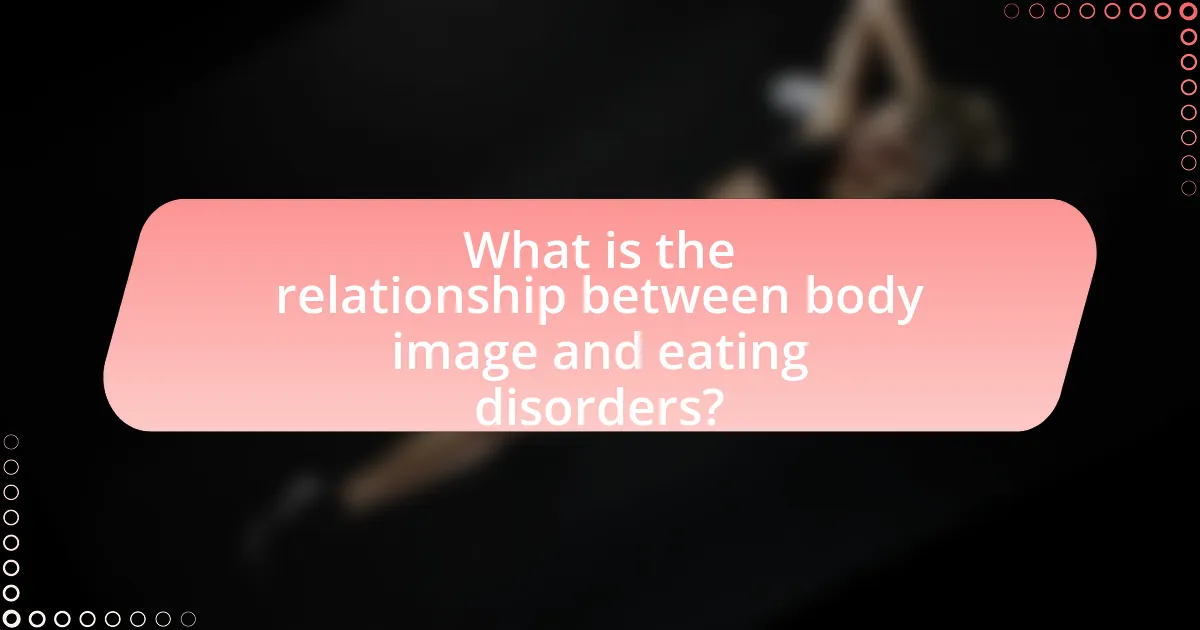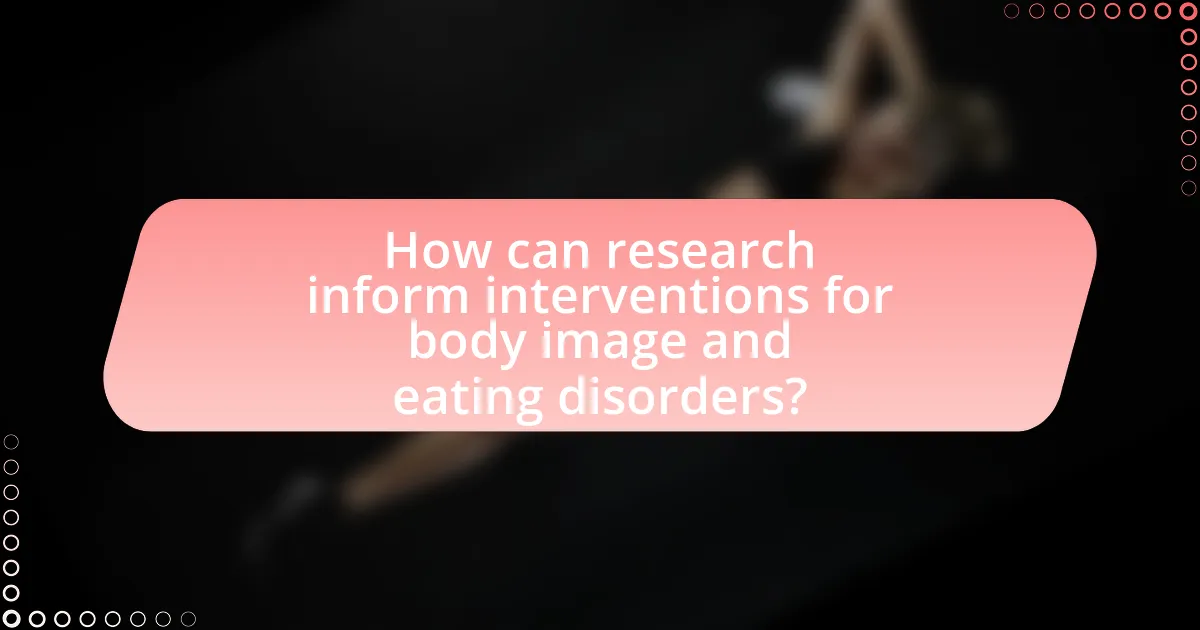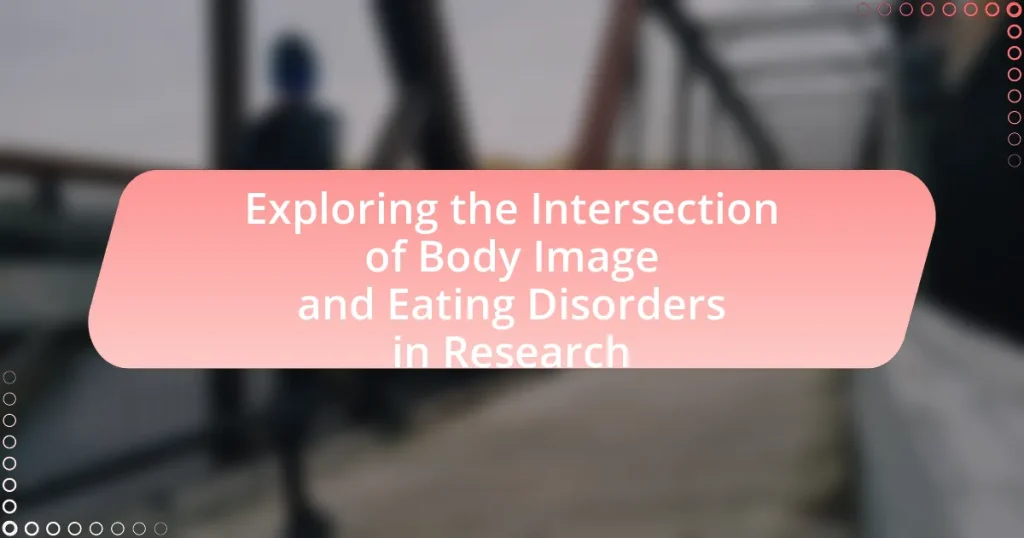The article examines the critical relationship between body image and eating disorders, highlighting how negative body image serves as a significant risk factor for conditions such as anorexia nervosa, bulimia nervosa, and binge eating disorder. It discusses the influence of societal standards and media representations on body image perceptions, as well as the psychological factors, including low self-esteem and perfectionism, that contribute to body image issues. The article also explores cultural differences in body image ideals, the connection between body dysmorphic disorder and eating disorders, and the importance of integrating body image interventions into treatment and prevention strategies. Through a review of relevant research, the article underscores the need for a comprehensive understanding of these interconnected issues to improve mental health outcomes for individuals affected by eating disorders.

What is the relationship between body image and eating disorders?
The relationship between body image and eating disorders is significant, as negative body image is a major risk factor for the development of eating disorders. Research indicates that individuals who perceive their bodies as unattractive or who are dissatisfied with their weight are more likely to engage in disordered eating behaviors. For instance, a study published in the journal “Eating Disorders” found that 70% of women with eating disorders reported a negative body image, highlighting the correlation between these two factors. Furthermore, the National Eating Disorders Association states that poor body image can lead to unhealthy dieting practices, which may escalate into full-blown eating disorders such as anorexia nervosa or bulimia nervosa.
How do societal standards influence body image perceptions?
Societal standards significantly influence body image perceptions by establishing ideals of attractiveness that individuals often strive to meet. These standards, perpetuated through media, cultural norms, and peer influences, create a benchmark for physical appearance that can lead to dissatisfaction and negative self-image. Research indicates that exposure to idealized body types in media correlates with increased body dissatisfaction among viewers, particularly among adolescents. For instance, a study published in the journal “Body Image” by Perloff (2014) found that social media usage is linked to higher levels of body image concerns, as users compare themselves to curated images that reflect societal ideals. This comparison can foster feelings of inadequacy and contribute to the development of eating disorders, highlighting the profound impact of societal standards on individual body image perceptions.
What role do media representations play in shaping body image?
Media representations significantly influence body image by establishing societal standards of beauty and desirability. These representations often promote unrealistic body ideals, which can lead to negative self-perception and body dissatisfaction among individuals. Research indicates that exposure to idealized images in media correlates with increased body dissatisfaction, particularly among adolescents and young adults. For instance, a study published in the journal “Body Image” by Tiggemann and Slater (2014) found that girls who frequently viewed thin-ideal images reported lower body satisfaction. This demonstrates that media portrayals not only reflect but also shape cultural norms regarding body image, impacting individuals’ self-esteem and potentially contributing to the development of eating disorders.
How do cultural differences affect body image and eating disorders?
Cultural differences significantly influence body image and the prevalence of eating disorders. Various cultures have distinct ideals of beauty and body shape, which can lead to differing perceptions of self-worth and attractiveness. For instance, Western cultures often emphasize thinness as the ideal, contributing to higher rates of anorexia and bulimia, while some non-Western cultures may value larger body sizes as symbols of wealth and health, potentially leading to different eating behaviors and attitudes towards body image. Research indicates that exposure to Western media can increase body dissatisfaction and eating disorders in cultures that traditionally held different standards, as seen in studies like those by Becker et al. (2002) in Fiji, where the introduction of television correlated with a rise in eating disorders among young women. Thus, cultural context plays a crucial role in shaping body image perceptions and the risk of developing eating disorders.
What psychological factors contribute to body image issues?
Psychological factors contributing to body image issues include low self-esteem, perfectionism, and social comparison. Low self-esteem often leads individuals to perceive their bodies negatively, as they may feel unworthy or inadequate. Perfectionism drives unrealistic standards for appearance, causing dissatisfaction with one’s body. Social comparison, particularly in the context of media portrayals of beauty, exacerbates body image concerns by fostering feelings of inadequacy when individuals compare themselves to idealized images. Research indicates that these factors are interrelated; for instance, a study published in the journal “Body Image” found that individuals with higher levels of perfectionism and social comparison tendencies reported greater body dissatisfaction.
How does self-esteem impact body image and eating disorders?
Self-esteem significantly impacts body image and the development of eating disorders. Individuals with low self-esteem often perceive their bodies negatively, leading to distorted body image and unhealthy eating behaviors. Research indicates that low self-esteem is a strong predictor of disordered eating patterns, as individuals may engage in restrictive dieting or binge eating to cope with feelings of inadequacy. A study published in the Journal of Eating Disorders found that low self-esteem correlates with higher levels of body dissatisfaction, which in turn increases the risk of developing eating disorders such as anorexia and bulimia. This relationship underscores the importance of addressing self-esteem in interventions aimed at improving body image and preventing eating disorders.
What is the connection between body dysmorphic disorder and eating disorders?
Body dysmorphic disorder (BDD) and eating disorders are closely connected through their shared focus on distorted body image and self-perception. Individuals with BDD often obsess over perceived flaws in their appearance, which can lead to unhealthy behaviors, including those seen in eating disorders, such as anorexia nervosa or bulimia nervosa. Research indicates that approximately 30% of individuals with BDD also meet the criteria for an eating disorder, highlighting the significant overlap between these conditions. This connection is further supported by studies showing that both disorders can stem from similar psychological factors, including low self-esteem and societal pressures regarding appearance.
Why is it important to study the intersection of body image and eating disorders?
Studying the intersection of body image and eating disorders is crucial because negative body image is a significant risk factor for the development of eating disorders. Research indicates that individuals with a distorted perception of their body are more likely to engage in unhealthy eating behaviors, leading to conditions such as anorexia nervosa and bulimia. For instance, a study published in the Journal of Eating Disorders found that 70% of individuals with eating disorders reported dissatisfaction with their body image, highlighting the direct correlation between these two areas. Understanding this relationship can inform prevention and treatment strategies, ultimately improving mental health outcomes for affected individuals.
What implications does this research have for treatment approaches?
This research indicates that treatment approaches for eating disorders must integrate body image interventions to be effective. Studies show that negative body image significantly contributes to the development and maintenance of eating disorders, suggesting that addressing body image issues can enhance treatment outcomes. For instance, a meta-analysis published in the Journal of Eating Disorders found that interventions targeting body image led to a reduction in disordered eating behaviors and improved psychological well-being. Therefore, incorporating body image-focused therapies into existing treatment protocols can provide a more holistic approach to managing eating disorders.
How can understanding this intersection inform prevention strategies?
Understanding the intersection of body image and eating disorders can inform prevention strategies by highlighting the psychological and social factors that contribute to these conditions. Research indicates that negative body image is a significant predictor of disordered eating behaviors, as evidenced by a study published in the Journal of Eating Disorders, which found that individuals with a distorted perception of their body are more likely to engage in harmful eating practices. By addressing body image issues through educational programs and media literacy initiatives, prevention strategies can reduce the risk of developing eating disorders. Furthermore, incorporating mental health support that focuses on self-esteem and body acceptance can enhance the effectiveness of these prevention efforts, as shown in interventions that have successfully decreased the prevalence of eating disorders among at-risk populations.

What are the different types of eating disorders related to body image?
The different types of eating disorders related to body image include anorexia nervosa, bulimia nervosa, binge eating disorder, and body dysmorphic disorder. Anorexia nervosa is characterized by an intense fear of gaining weight and a distorted body image, leading to severe restriction of food intake. Bulimia nervosa involves cycles of binge eating followed by compensatory behaviors such as vomiting or excessive exercise, often driven by concerns about body shape and weight. Binge eating disorder is marked by recurrent episodes of eating large quantities of food, accompanied by feelings of loss of control and distress, often linked to negative body image. Body dysmorphic disorder, while not classified as an eating disorder, involves an obsessive focus on perceived flaws in appearance, which can lead to unhealthy eating behaviors. These disorders are supported by research indicating that negative body image is a significant risk factor for their development.
What are the characteristics of anorexia nervosa?
Anorexia nervosa is characterized by an intense fear of gaining weight, a distorted body image, and severe restriction of food intake. Individuals with this disorder often exhibit extreme weight loss, leading to significantly low body weight relative to age, sex, and developmental trajectory. Additionally, they may engage in excessive exercise, have a preoccupation with food, dieting, and body shape, and may experience physical symptoms such as amenorrhea in females. Research indicates that these characteristics are associated with psychological factors, including anxiety and perfectionism, which further complicate the disorder.
How does body image distortion manifest in anorexia?
Body image distortion in anorexia manifests primarily through an intense preoccupation with weight and body shape, leading individuals to perceive themselves as overweight despite being underweight. This distorted self-image results in behaviors such as extreme dieting, excessive exercise, and a refusal to maintain a healthy body weight. Research indicates that individuals with anorexia often exhibit cognitive biases that reinforce their negative body image, such as selective attention to perceived flaws and a lack of insight into their actual physical condition. Studies have shown that up to 90% of individuals with anorexia nervosa report significant body image distortion, highlighting its prevalence and impact on their mental health and behavior.
What are the long-term effects of anorexia on body image?
The long-term effects of anorexia on body image include persistent negative self-perception, distorted body image, and increased risk of developing body dysmorphic disorder. Individuals recovering from anorexia often continue to view themselves as overweight or unattractive, despite achieving a healthier weight. Research indicates that approximately 50% of individuals with a history of anorexia experience ongoing body dissatisfaction years after recovery, highlighting the lasting impact of the disorder on self-image. Additionally, studies show that these individuals may struggle with social anxiety and low self-esteem, further complicating their relationship with body image.
What defines bulimia nervosa and its relationship with body image?
Bulimia nervosa is defined as an eating disorder characterized by recurrent episodes of binge eating followed by compensatory behaviors such as vomiting, excessive exercise, or fasting. This disorder is closely linked to body image, as individuals with bulimia often have a distorted perception of their body size and shape, leading to an intense fear of gaining weight. Research indicates that negative body image significantly contributes to the development and maintenance of bulimia nervosa, with studies showing that individuals with this disorder frequently engage in behaviors aimed at achieving an idealized body image, which is often unattainable. For instance, a study published in the “International Journal of Eating Disorders” by Stice et al. (2009) found that body dissatisfaction is a strong predictor of bulimic symptoms, highlighting the critical relationship between body image and the disorder.
How do binge-eating episodes relate to body image perception?
Binge-eating episodes are closely linked to negative body image perception, as individuals who engage in binge eating often experience feelings of shame and dissatisfaction with their bodies. Research indicates that those with a distorted body image are more likely to engage in binge-eating behaviors, as they may use food as a coping mechanism for their negative self-perception. A study published in the journal “Eating Behaviors” found that individuals with higher levels of body dissatisfaction reported more frequent binge-eating episodes, highlighting the correlation between body image issues and disordered eating patterns.
What are the psychological impacts of bulimia on body image?
Bulimia significantly distorts body image, leading to negative self-perception and dissatisfaction. Individuals with bulimia often experience a preoccupation with weight and shape, which can result in feelings of shame, guilt, and low self-esteem. Research indicates that this disorder is associated with a higher prevalence of body dissatisfaction, as evidenced by a study published in the International Journal of Eating Disorders, which found that 80% of individuals with bulimia reported a distorted body image. This distorted perception can perpetuate a cycle of bingeing and purging, further exacerbating psychological distress and reinforcing negative body image.
What is binge eating disorder and how does it connect to body image?
Binge eating disorder (BED) is a psychological condition characterized by recurrent episodes of eating large quantities of food, often quickly and to the point of discomfort, accompanied by feelings of loss of control and distress. This disorder is closely linked to body image issues, as individuals with BED often struggle with negative perceptions of their body, leading to emotional eating as a coping mechanism. Research indicates that approximately 2-3% of the population experiences BED, and studies show that individuals with this disorder frequently report dissatisfaction with their body shape and weight, which exacerbates their eating behaviors.
How does societal pressure influence binge eating behaviors?
Societal pressure significantly influences binge eating behaviors by promoting unrealistic body standards and stigmatizing certain body types. This pressure often leads individuals to engage in unhealthy eating patterns as a coping mechanism to deal with feelings of inadequacy or stress related to their body image. Research indicates that exposure to media portrayals of idealized body types correlates with increased body dissatisfaction, which is a known risk factor for binge eating. For instance, a study published in the journal “Eating Disorders” found that individuals who frequently consume media with thin-ideal images are more likely to experience disordered eating behaviors, including binge eating.
What are the treatment options for binge eating disorder related to body image?
Cognitive Behavioral Therapy (CBT) is a primary treatment option for binge eating disorder related to body image, as it addresses the negative thoughts and behaviors associated with eating and self-perception. Research indicates that CBT can significantly reduce binge eating episodes and improve body image satisfaction. A study published in the Journal of Consulting and Clinical Psychology found that individuals receiving CBT showed a 50% reduction in binge eating episodes and improved body image after treatment. Additionally, medications such as selective serotonin reuptake inhibitors (SSRIs) have been shown to help reduce binge eating behaviors and improve mood, further supporting body image enhancement. These treatment options are effective in addressing the psychological aspects of binge eating disorder and its relationship with body image.

How can research inform interventions for body image and eating disorders?
Research can inform interventions for body image and eating disorders by identifying risk factors, understanding the psychological mechanisms involved, and evaluating the effectiveness of treatment approaches. For instance, studies have shown that cognitive-behavioral therapy (CBT) significantly reduces symptoms of eating disorders by addressing distorted body image perceptions (Fairburn et al., 2015, “Cognitive Behavior Therapy for Eating Disorders,” The British Journal of Psychiatry). Additionally, research highlights the role of social media in shaping body image, suggesting that interventions targeting media literacy can mitigate negative effects (Perloff, 2014, “Social Media Effects on Young Women’s Body Image Concerns: Theoretical Perspectives and an Agenda for Research,” Sex Roles). By utilizing these insights, practitioners can develop tailored interventions that effectively address the underlying issues related to body image and eating disorders.
What methodologies are used in research on body image and eating disorders?
Research on body image and eating disorders employs various methodologies, including quantitative surveys, qualitative interviews, and experimental designs. Quantitative surveys, such as the Eating Attitudes Test (EAT-26), provide statistical data on eating behaviors and attitudes, allowing researchers to identify trends and correlations. Qualitative interviews offer in-depth insights into personal experiences and perceptions related to body image, revealing the complexities of individual narratives. Experimental designs, often involving controlled trials, assess the effects of interventions aimed at improving body image or reducing disordered eating behaviors. These methodologies collectively contribute to a comprehensive understanding of the psychological and social factors influencing body image and eating disorders.
How do qualitative studies contribute to understanding body image issues?
Qualitative studies contribute to understanding body image issues by providing in-depth insights into individuals’ personal experiences and perceptions. These studies utilize methods such as interviews and focus groups, allowing researchers to capture the complexities of body image as it relates to cultural, social, and psychological factors. For instance, a study by Tiggemann and Slater (2014) found that young women’s body image is significantly influenced by social media interactions, highlighting the role of external validation in shaping self-perception. This qualitative approach reveals the nuanced ways individuals internalize societal standards, which quantitative methods may overlook, thus enriching the overall understanding of body image issues.
What role do quantitative studies play in measuring the impact of body image on eating disorders?
Quantitative studies play a crucial role in measuring the impact of body image on eating disorders by providing statistical data that establishes correlations and causal relationships. These studies utilize structured methodologies, such as surveys and experiments, to gather numerical data on individuals’ body image perceptions and their prevalence of eating disorders. For instance, research published in the journal “Eating Behaviors” found that negative body image significantly correlates with higher rates of anorexia and bulimia, demonstrating the measurable impact of body image on these disorders. By analyzing large sample sizes, quantitative studies can identify trends and risk factors, thereby informing prevention and intervention strategies in clinical settings.
What are the best practices for addressing body image in treatment settings?
The best practices for addressing body image in treatment settings include fostering a supportive environment, utilizing cognitive-behavioral therapy (CBT), and incorporating body image-focused interventions. Creating a supportive environment encourages open discussions about body image, which can reduce stigma and promote healing. CBT has been shown to effectively challenge negative body image thoughts and behaviors, as evidenced by a study published in the Journal of Eating Disorders, which found that CBT significantly improved body image among individuals with eating disorders. Additionally, incorporating body image-focused interventions, such as body acceptance exercises and media literacy training, can help patients develop a healthier relationship with their bodies, as supported by research from the International Journal of Eating Disorders, which highlights the effectiveness of these approaches in improving body image satisfaction.
How can therapists incorporate body image work into eating disorder treatment?
Therapists can incorporate body image work into eating disorder treatment by utilizing cognitive-behavioral techniques that challenge negative beliefs about body image. These techniques include helping clients identify and reframe distorted thoughts related to their appearance, which has been shown to improve self-esteem and reduce disordered eating behaviors. Research indicates that addressing body image issues directly correlates with better treatment outcomes for eating disorders, as evidenced by a study published in the Journal of Eating Disorders, which found that patients who engaged in body image-focused therapy reported significant reductions in eating disorder symptoms.
What resources are available for individuals struggling with body image and eating disorders?
Individuals struggling with body image and eating disorders can access various resources, including professional treatment centers, support groups, and online platforms. Treatment centers like the National Eating Disorders Association (NEDA) provide comprehensive care, including therapy and medical support. Support groups, such as those offered by Eating Disorders Anonymous, facilitate peer support and shared experiences. Online resources, including NEDA’s helpline and websites like the Butterfly Foundation, offer information, guidance, and crisis support. These resources are validated by research indicating that early intervention and support significantly improve recovery outcomes for individuals facing these challenges.
What practical strategies can individuals use to improve body image?
Individuals can improve body image by practicing self-compassion, engaging in positive self-talk, and surrounding themselves with supportive people. Self-compassion involves treating oneself with kindness during moments of perceived inadequacy, which has been shown to enhance overall body satisfaction. Positive self-talk, or consciously replacing negative thoughts about one’s appearance with affirming statements, can lead to improved self-esteem and body image. Additionally, social support from friends and family can provide encouragement and reinforce a positive self-view, as studies indicate that individuals with strong social networks report better body image.


